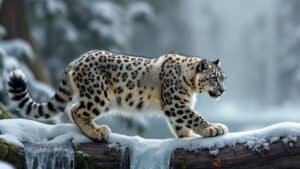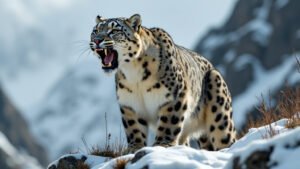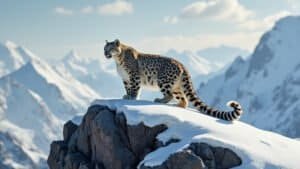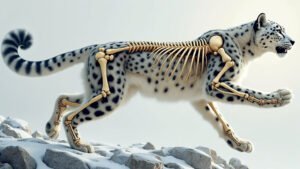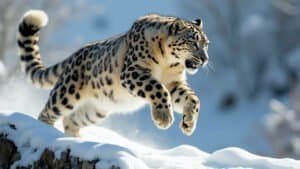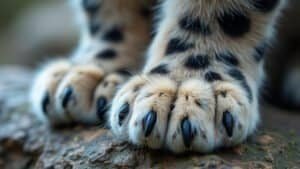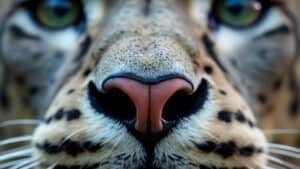Introduction
The snow leopard, a solitary and elusive predator, has a highly specialized digestive system that allows it to thrive on a carnivorous diet in the harsh, mountainous regions of Central and South Asia
This article explores the unique components of the snow leopard’s digestive system, the detailed process by which it digests meat, and the adaptations it has developed to handle tough prey and survive in cold environments
We also delve into common digestive health issues that these majestic creatures face and how they overcome these challenges to maintain their place at the top of the food chain
Components of a Snow Leopard’s Digestive System
Snow leopards, known for their elusive nature and ability to thrive in some of the most challenging terrains, possess a highly specialized digestive system that supports their carnivorous diet
This system is adapted to break down and absorb nutrients from the high-protein, high-fat diet they obtain from their prey, primarily wild sheep, goats, and other small mammals
Each component of their digestive system plays a crucial role in ensuring the efficient digestion and absorption of nutrients, allowing them to sustain themselves in cold, high-altitude environments
Mouth and Teeth Adaptations
The digestion process in snow leopards begins with their mouth and teeth, which are specifically adapted to capture and consume their prey. Snow leopards have sharp, conical canine teeth that are designed for gripping and piercing the flesh of their prey
These canines are supported by powerful jaw muscles that allow them to deliver a strong bite force, crucial for hunting and subduing large, often struggling prey. The carnassial teeth, which are the molars and premolars, are specially adapted for shearing flesh and crushing bones
Unlike herbivores, which have flat molars for grinding plant material, snow leopards’ carnassial teeth are designed to tear through muscle and sinew efficiently
The sharpness and arrangement of these teeth help in the initial mechanical breakdown of food, a process that is essential for the subsequent stages of digestion. Once the prey is subdued, snow leopards use their sharp incisors to strip flesh from bones and their carnassials to slice it into smaller, more manageable pieces. This initial mechanical digestion prepares the food for chemical digestion further down the digestive tract
Structure of the Stomach
Once the food is chewed and swallowed, it moves into the stomach, a muscular sac that plays a vital role in the digestion process. The snow leopard’s stomach is highly acidic, with a pH that can range between 1 and 2, similar to that of other carnivorous big cats
This acidity is crucial for breaking down tough proteins found in meat and for killing bacteria and parasites that might be present in their prey. The stomach lining contains glands that secrete gastric juices, including hydrochloric acid and pepsinogen, an inactive enzyme that becomes the protein-digesting enzyme pepsin in the acidic environment of the stomach
The stomach acts as a storage and processing chamber where large chunks of food are broken down into smaller, more digestible pieces. The muscular walls of the stomach churn and mix the food with digestive enzymes and acids, further breaking it down into a semi-liquid mixture called chyme
This churning action is aided by strong stomach muscles that can handle large, infrequent meals—a necessity for snow leopards that often have to go days between successful hunts
Function of the Small Intestine
After being processed in the stomach, chyme is gradually released into the small intestine, where most nutrient absorption occurs. The small intestine of a snow leopard is relatively short compared to that of herbivores, reflecting its specialization for a meat-based diet
This section of the digestive tract is divided into three parts: the duodenum, jejunum, and ileum. The duodenum receives digestive enzymes and bile from the pancreas and liver, which help in breaking down fats, proteins, and carbohydrates further
Pancreatic enzymes like trypsin, chymotrypsin, and lipase break down proteins and fats into their simpler components. The villi and microvilli lining the walls of the small intestine increase the surface area for absorption, allowing for efficient uptake of nutrients into the bloodstream
Here, amino acids, fatty acids, and simple sugars are absorbed, providing the snow leopard with the energy and nutrients necessary to sustain its high-energy lifestyle and muscular build
Role of the Large Intestine and Rectum
The remaining indigestible parts of the food, along with water and electrolytes, move into the large intestine. The large intestine in snow leopards is relatively short, which reflects its limited role in digesting plant materials, unlike in omnivores or herbivores
Instead, the large intestine primarily absorbs water and electrolytes from the undigested food matter. This process helps conserve water, which is particularly important for snow leopards living in arid, mountainous environments where water sources can be scarce
The remaining waste material is then formed into feces and stored in the rectum until it is excreted. The relatively small size of the large intestine also reduces the retention time of feces, preventing the buildup of harmful bacteria that could cause infections
This efficiency allows snow leopards to maintain a healthy digestive system while maximizing nutrient absorption from their carnivorous diet
The Digestion Process of Meat in Snow Leopards
Snow leopards are obligate carnivores, meaning their diet consists almost entirely of meat. Their digestive process is finely tuned to break down protein-rich and fatty foods, allowing them to extract essential nutrients efficiently
Understanding this process involves exploring the mechanical and chemical digestion that takes place as meat travels through various parts of the digestive system, from the stomach to the intestines
Breakdown of Meat in the Stomach
The digestion of meat in snow leopards begins primarily in the stomach. After the initial mechanical breakdown by teeth in the mouth, swallowed chunks of meat enter the stomach
The snow leopard’s stomach has strong muscular walls that churn the meat, mixing it with digestive acids and enzymes. This churning not only physically breaks down the meat into smaller particles but also ensures thorough mixing with gastric juices, which are crucial for chemical digestion
Hydrochloric acid (HCl) is a major component of these gastric juices. The stomach lining secretes HCl, creating a highly acidic environment (pH 1-2) that denatures the complex proteins found in the muscle tissues of prey
This acidity is vital for the activation of pepsinogen into pepsin, the main enzyme responsible for breaking down proteins into smaller peptides. Pepsin cleaves the long chains of amino acids in the proteins into shorter fragments, which are more easily absorbed later in the small intestine
Furthermore, the high acidity of the stomach serves another critical purpose: it acts as a barrier against pathogens. Since snow leopards often consume raw meat, including the fur and sometimes even bones of their prey, their stomach acid is potent enough to kill most bacteria, parasites, and other harmful microorganisms that could be present
Enzymatic Activity and Protein Digestion
Enzymatic activity is crucial in the digestion of meat. Once the food reaches the stomach, the enzymatic breakdown of proteins begins with pepsin, which works optimally in the highly acidic environment
Pepsin targets peptide bonds within the protein molecules, breaking them down into smaller polypeptides and peptides. This breakdown continues until the food is sufficiently liquefied into chyme, a semi-fluid mass of partially digested food, ready to move into the small intestine
In the small intestine, enzymes from the pancreas further digest proteins. Trypsin and chymotrypsin, secreted in their inactive forms and activated in the duodenum, continue the work started by pepsin. These enzymes break down the polypeptides into even smaller peptide fragments and single amino acids, which are the basic building blocks of proteins
Amino acids are then absorbed through the intestinal walls into the bloodstream, providing the essential nutrients required for muscle repair, enzyme production, and other vital functions
Additionally, lipase enzymes are secreted to break down fats into fatty acids and glycerol. Since snow leopards consume prey with significant fat content, such as the fatty tissues around organs and under the skin, these enzymes are vital for processing their high-fat diet
Bile, produced by the liver and stored in the gallbladder, is also released into the small intestine to emulsify fats, making them easier for lipase enzymes to break down
Absorption of Nutrients in the Small Intestine
The small intestine is the primary site for nutrient absorption in snow leopards. After passing through the stomach, the chyme enters the duodenum, the first segment of the small intestine, where it is exposed to pancreatic juices and bile
This mixture further breaks down the remaining nutrients into their simplest forms: amino acids, fatty acids, glycerol, and simple sugars
The lining of the small intestine is covered with tiny, finger-like projections called villi and microvilli, which significantly increase the surface area for absorption. The increased surface area allows for maximum absorption of nutrients
Amino acids and simple sugars are absorbed directly into the bloodstream through the intestinal walls, while fatty acids and glycerol are absorbed into the lymphatic system before being transported to the bloodstream
The small intestine’s efficient absorption capabilities enable snow leopards to extract the maximum amount of nutrients from each meal, which is essential given the often harsh and resource-scarce environments they inhabit
The nutrients absorbed here provide the energy needed for their active and predatory lifestyle and support their overall health and reproductive functions
Elimination of Waste and Indigestible Parts
Not all parts of a snow leopard’s prey are digestible. Elements like fur, feathers, and certain bones cannot be broken down by the digestive system and must be excreted. After passing through the small intestine, the indigestible parts, along with some undigested materials, enter the large intestine
Here, water is reabsorbed to maintain hydration, especially critical for snow leopards living in arid, cold regions where liquid water is less accessible
The large intestine’s main role is not nutrient absorption but rather the consolidation of waste. The remaining material is compacted into feces, which is eventually excreted. The efficient excretion of indigestible materials prevents digestive blockages and maintains the health of the digestive tract
Interestingly, the fur and bones sometimes appear in the leopard’s scat, providing indirect evidence of their prey choices to researchers studying these elusive predators
Digestive Adaptations for a Carnivorous Diet
Snow leopards, as apex predators, have developed several unique adaptations in their digestive systems to efficiently process a carnivorous diet. These adaptations help them digest tough, protein-rich prey and deal with the indigestible parts like bones, fur, and feathers
The efficiency of their digestive system ensures they extract maximum nutrients from each meal, which is crucial for survival in their rugged, cold habitats
Handling Bones and Tough Tissue
One of the most remarkable adaptations in the snow leopard’s digestive system is its ability to process bones and tough tissues. While not all bones are digested, snow leopards consume a significant amount of bone material when feeding on their prey
Their strong stomach acids, with a pH as low as 1, are capable of breaking down softer bones, cartilage, and tough connective tissues. This ability to digest bones is advantageous because it provides access to the rich marrow inside, which is high in fat and nutrients
Moreover, their sharp carnassial teeth, along with their powerful jaw muscles, enable them to crush and break down bones into smaller fragments before ingestion. This mechanical breakdown is the first step in processing these otherwise hard-to-digest materials. The ingestion of bones also helps maintain dental health by scraping off plaque, reducing the likelihood of dental disease
However, snow leopards selectively avoid the densest bones, such as the large leg bones of ungulates, which are too tough even for their powerful digestive systems. The consumption of smaller bones and tougher tissues maximizes nutrient intake while minimizing the risk of gastrointestinal injuries
Dealing with Fur and Feathers
Another adaptation seen in snow leopards is their ability to manage indigestible parts of their prey, such as fur and feathers. Unlike other carnivores, snow leopards do not meticulously pluck the fur or feathers off their prey
Instead, they consume it along with the meat and bones. The fur and feathers serve an important purpose in their diet; they act as a natural fiber that aids in the digestive process
Fur and feathers help in the formation of compact fecal matter, which can more easily pass through the digestive tract. This reduces the risk of gastrointestinal blockages or complications that can arise from bone shards or other sharp indigestible items
The undigested fur and feathers are excreted as part of the scat, which also helps clean out the digestive tract, preventing the buildup of harmful bacteria
These indigestible materials are often excreted in a tightly packed form, known as a “scat plug,” which is a distinctive characteristic of felines. This unique way of handling indigestible parts helps maintain digestive health and allows the snow leopard to consume as much of its prey as possible without discarding potentially valuable nutrients
Quick and Efficient Digestion Mechanisms
Given the scarcity of prey and the difficulty of hunting in their mountainous environments, snow leopards need to digest their food quickly and efficiently. They have adapted to eat large amounts of food in one sitting and then go without eating for several days
This feast-and-fast strategy requires a highly efficient digestive system that can process a large intake of food quickly
Their stomach can expand significantly to hold large amounts of food, sometimes up to 20% of their body weight. This allows snow leopards to maximize their nutrient intake from each successful hunt
After a large meal, the stomach’s muscular contractions and high acidity rapidly begin breaking down food. This quick digestion is essential because it allows snow leopards to move away from a kill site more rapidly, minimizing the risk of confrontations with scavengers or other predators
Additionally, the snow leopard’s digestive system is adapted to extract a high level of energy from fat, which is crucial for their survival in cold, high-altitude environments. Fats provide more than twice the energy per gram compared to carbohydrates or proteins, making them a vital component of the snow leopard’s diet
By efficiently breaking down these fats through lipase enzymes and bile salts, snow leopards can sustain long periods of physical exertion while patrolling their vast territories
Digestion in Cold Environments
Snow leopards inhabit some of the most extreme and cold environments on the planet, ranging from the high mountains of Central Asia to the steep, rocky terrains of the Himalayas
Surviving in these harsh conditions requires more than just physical adaptations; their digestive system must also be optimized to function efficiently in cold weather. The snow leopard’s digestive process is tailored to maximize energy extraction and maintain body heat, crucial for survival in freezing temperatures
Impact of Cold on Digestive Efficiency
The cold environments that snow leopards inhabit can significantly affect the efficiency of their digestion
In low temperatures, the body prioritizes maintaining core temperature, which can potentially slow down digestion as blood flow is redirected to vital organs like the brain and heart. To counteract this, snow leopards have evolved to maintain efficient digestion even when exposed to freezing conditions
Their highly acidic stomach plays a role in keeping the digestive process efficient. The strong stomach acids help break down food quickly, reducing the time that food stays in the stomach. This rapid digestion is crucial in cold environments because prolonged digestion could lead to a drop in the internal temperature
Additionally, the energy derived from the rapid breakdown of fats and proteins in their food is quickly utilized to generate heat, a process known as thermogenesis, which is vital for maintaining body warmth
Another adaptation is their ability to digest large meals. Eating large amounts of meat at once allows snow leopards to generate significant metabolic heat as they digest their food, which can be especially useful in cold climates. This “heat-producing” digestion helps to offset the energy loss from the cold and contributes to overall thermoregulation
Energy Requirements and Metabolism
In cold environments, snow leopards face high energy demands. The energy requirement of snow leopards is considerably higher than that of many other carnivores living in more temperate climates
This increased energy demand is due to both their active lifestyle and the need to maintain body heat in cold, high-altitude environments. As a result, snow leopards rely on a metabolism that is highly efficient at extracting energy from their carnivorous diet
Their metabolism is designed to process large quantities of animal fat, which provides more than twice the energy of carbohydrates or proteins per gram. This fat-rich diet is especially important in cold climates, where maintaining a high body temperature requires substantial energy. The rapid conversion of these fats into usable energy helps snow leopards stay active and alert, even when temperatures plummet
The efficiency of their metabolism is also linked to their hunting behavior. Snow leopards often face long periods between successful hunts, which means they need to maximize energy storage from each meal
The digestion of fat and protein provides a slow and steady release of energy, allowing snow leopards to sustain their energy levels over several days without eating
Strategies for Maximizing Nutrient Absorption
To survive in cold environments where food is scarce, snow leopards have evolved strategies to maximize nutrient absorption from their prey
One such strategy involves the anatomy of their small intestine, which is specialized for absorbing as many nutrients as possible from their meat-based diet. The villi and microvilli in the small intestine increase the surface area for nutrient absorption, ensuring that every available nutrient from a meal is absorbed
Furthermore, the snow leopard’s digestive system is geared towards conserving water, which is particularly important in the cold, arid regions they inhabit. The reabsorption of water in the large intestine prevents dehydration and ensures that snow leopards do not lose vital fluids in a landscape where liquid water can be scarce due to freezing temperatures
Another critical adaptation is their ability to eat a wide variety of prey. While their preferred prey consists of wild sheep and goats, they are also known to eat small mammals, birds, and even carrion
This dietary flexibility ensures they can obtain essential nutrients even when their primary food sources are not available. By being opportunistic feeders, snow leopards maximize their chances of survival in their cold, high-altitude habitats
Common Digestive Health Issues in Snow Leopards
While snow leopards are well-adapted to their carnivorous diet and harsh environments, they are not immune to digestive health issues. Several factors, including their diet, environment, and the challenges of their natural habitat, can lead to digestive problems
Understanding these common issues is essential for conservation efforts, particularly for those snow leopards living in captivity where diet and habitat conditions differ from the wild
Parasites and Their Effects on Digestion
Parasites are a significant concern for snow leopards, both in the wild and in captivity. Intestinal parasites such as roundworms, tapeworms, and hookworms can be ingested through contaminated prey or water sources
Once inside the digestive tract, these parasites can cause a range of problems, from mild discomfort to severe malnutrition and gastrointestinal distress
Parasites often compete with the host for nutrients, which can lead to weight loss, weakness, and poor coat condition. In more severe cases, parasites can cause blockages in the intestines, leading to a potentially life-threatening situation
Studies have shown that wild snow leopards often have higher parasite loads due to their exposure to infected prey and water sources compared to those in captivity, where food and water are controlled and sanitized
Regular deworming and fecal examinations are critical in managing parasitic infections, especially in captivity. Conservation programs must be aware of these risks and implement proper veterinary care to maintain the health of snow leopards
Signs of Digestive Disorders
Digestive disorders in snow leopards can manifest in several ways, and recognizing the signs early is crucial for effective treatment. Symptoms of digestive problems can include vomiting, diarrhea, bloating, constipation, and changes in appetite or weight
In some cases, these symptoms may be indicative of a more severe underlying condition, such as inflammatory bowel disease (IBD), infections, or even foreign body ingestion
IBD, for example, is an immune-mediated condition that causes chronic inflammation of the digestive tract and has been observed in captive snow leopards. This condition can result from stress, changes in diet, or underlying genetic factors
In the wild, digestive disorders can be harder to diagnose but are no less concerning. Chronic issues can severely impact a snow leopard’s ability to hunt and sustain itself, particularly in harsh environments where food is scarce
Monitoring these signs and conducting regular health checks, including blood tests, fecal analysis, and endoscopy if needed, can help in early detection and management of digestive issues in snow leopards, especially in captivity
Preventive Measures and Treatments
Preventive care is the cornerstone of maintaining digestive health in snow leopards, particularly those in zoos or conservation programs. In captivity, snow leopards are at risk of developing digestive issues due to changes in diet and lack of physical activity compared to their wild counterparts
To mitigate these risks, it is crucial to provide a diet that mimics their natural food sources as closely as possible, including raw meat and bones, to stimulate natural chewing and digestion
Regular veterinary care, including deworming and vaccinations, is essential to prevent and control infections. Parasite prevention strategies include maintaining clean enclosures, controlling rodent populations that could act as intermediate hosts for parasites, and providing clean water sources
Additionally, stress management plays a critical role in preventing digestive issues. Snow leopards are solitary and territorial by nature, and overcrowding or frequent changes in their environment can lead to stress, which can exacerbate digestive problems. Providing ample space, enrichment activities, and a stable, quiet environment can significantly reduce stress levels, promoting overall health
For snow leopards in the wild, maintaining a healthy population of prey and minimizing human-wildlife conflict is crucial. A consistent food supply reduces the likelihood of consuming suboptimal or contaminated prey, thereby reducing the risk of digestive issues
Conclusion
The snow leopard’s digestive system is a marvel of adaptation, finely tuned to handle a strictly carnivorous diet in some of the harshest environments on Earth. From its sharp teeth and powerful stomach acids to the highly efficient small intestine, every part of the digestive system is optimized for breaking down and absorbing nutrients from meat, fat, and even bones
These adaptations are crucial for survival, allowing snow leopards to thrive on sporadic, high-calorie meals and maintain energy levels in cold, high-altitude habitats. However, challenges such as parasites, digestive disorders, and environmental stresses pose risks to their digestive health
Through a combination of natural adaptations and human-led conservation efforts, these majestic predators continue to navigate the delicate balance of their digestive health in both the wild and captivity




